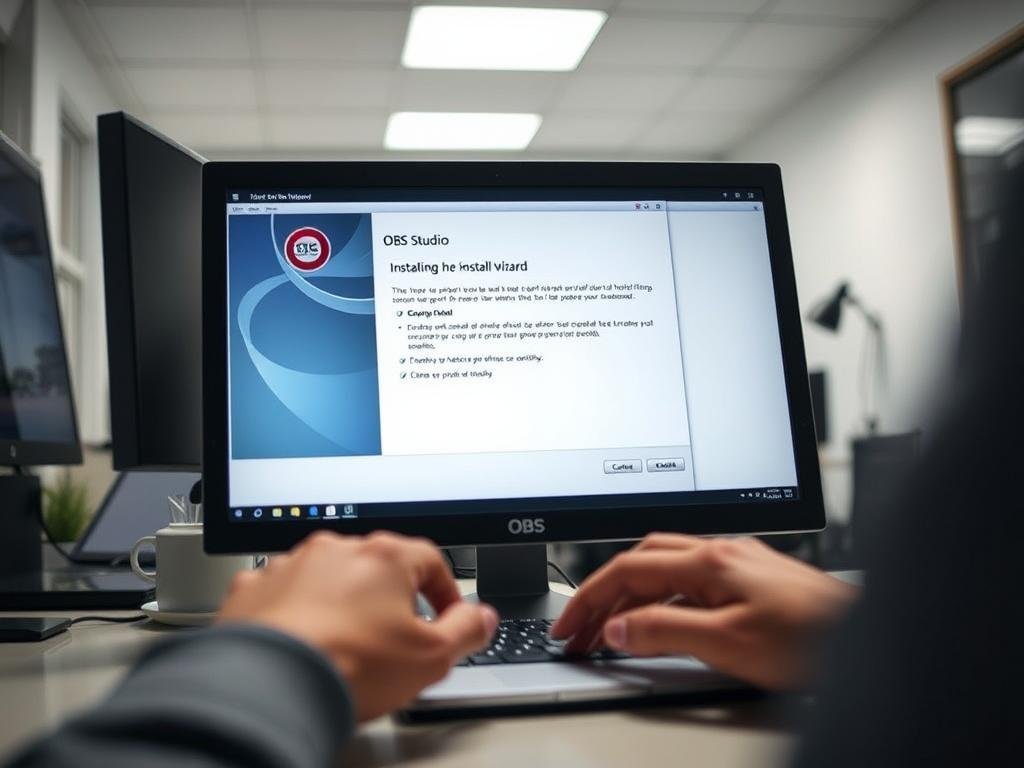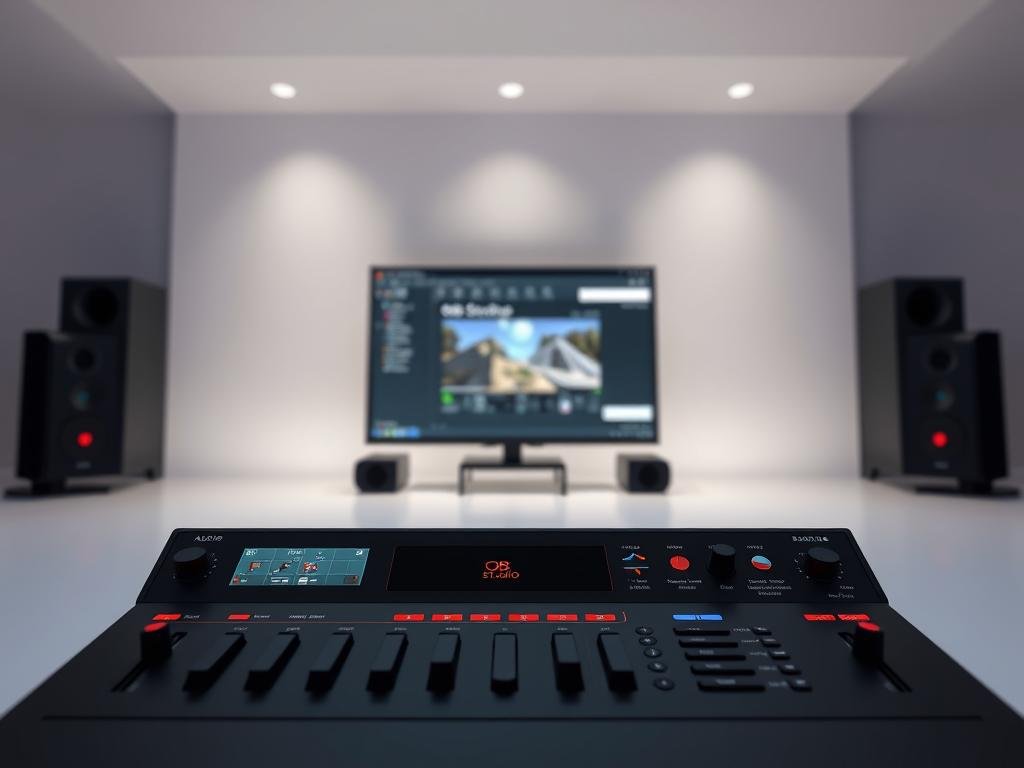“The best way to predict the future is to create it.” – Peter Drucker. This quote perfectly captures the essence of streaming. With the right tools, you can shape your content and connect with your audience like never before.
OBS Studio is a free, open-source software that empowers creators to stream and record with professional quality. Whether you’re on Windows, macOS, or Ubuntu, it supports 39 languages, making it accessible to a global audience.
Its features include live streaming to platforms like Twitch, YouTube, and Facebook, multi-source mixing, and noise reduction. Proper setup is crucial for delivering high-quality streams, and this guide will walk you through the installation and optimization process.
Ready to elevate your streaming game? Let’s dive in and unlock the full potential of OBS Studio.
Introduction to OBS Studio
OBS Studio is a versatile tool for both recording and live streaming. It’s part of the OBS Project, which focuses on providing free, open-source software for content creators. Whether you’re capturing gameplay, hosting a webinar, or streaming live events, this platform has the features you need.
One of its standout capabilities is advanced audio handling. You can capture real-time audio, mix multiple sources, and apply noise suppression filters. This ensures your audience hears crystal-clear sound, even in noisy environments.
OBS Studio supports a wide range of operating systems, including Windows 10/11, macOS Catalina+, and Ubuntu 18.04+. It also integrates seamlessly with major streaming platforms like Twitch, YouTube, and Facebook Gaming. This makes it easy to broadcast your content to your preferred audience.
For enhanced performance, the software supports hardware encoding through NVIDIA NVENC, AMD AMF, and Intel Quick Sync. This reduces the load on your CPU, ensuring smoother streaming and recording experiences.
| Supported Platforms | Hardware Encoding |
|---|---|
| Windows 10/11 | NVIDIA NVENC |
| macOS Catalina+ | AMD AMF |
| Ubuntu 18.04+ | Intel Quick Sync |
With its robust features and cross-platform compatibility, OBS Studio is a must-have for anyone serious about content creation. The latest version of OBS Studio continues to push boundaries, offering tools that empower creators to deliver professional-quality streams and recordings.
How to Install OBS Studio
Getting started with OBS Studio is straightforward, but choosing the right installation method is key. Whether you’re on Windows, macOS, or Ubuntu, this guide will walk you through the process step by step.
Downloading OBS Studio
Begin by downloading the latest version of OBS Studio from the official OBS Project website or GitHub releases. Always verify the installer’s authenticity using the provided checksum. This ensures the files are secure and unaltered.

Installation Methods
There are two primary ways to set up OBS Studio: using the graphical installer or package managers. The graphical installer is user-friendly and ideal for beginners. Package managers like winget for Windows or Homebrew for macOS offer an alternative installation method for advanced users.
For Windows, ensure you have the necessary security permissions if installing outside the default Program Files directory. On macOS, the .dmg file simplifies the process, while Homebrew provides a command-line option.
Installation on Different Operating Systems
Each operating system has unique requirements. For Windows, you can use winget, Chocolatey, or Scoop commands. These tools streamline the process and handle dependencies automatically.
On macOS, the .dmg file is the most common method. Alternatively, Homebrew cask offers a quick terminal-based setup. For Ubuntu, you’ll need to install FFmpeg and set up the PPA repository via terminal commands.
Here’s a quick comparison of installation methods:
| Operating System | Installation Method |
|---|---|
| Windows | winget, Chocolatey, Scoop |
| macOS | .dmg file, Homebrew cask |
| Ubuntu | Terminal commands, PPA repository |
If you encounter issues during the process, refer to the official OBS wiki or community forums for troubleshooting tips. Proper setup ensures you can focus on creating high-quality content without technical hiccups.
Configuring OBS Studio for Streaming
Streaming success starts with proper configuration. Once you’ve set up OBS Studio, the next step is tailoring it to your needs. This ensures smooth performance and professional-quality streams.
Initial Setup and Auto-Configuration Wizard
The auto-configuration wizard is your first stop. It analyzes your hardware and recommends optimal settings. This includes resolution, bitrate, and encoder preferences based on your system’s capabilities.
For example, if you’re using a mid-range PC, the wizard might suggest a 720p resolution with a bitrate of 3000 kbps. These settings balance quality and performance, ensuring your stream runs smoothly without overloading your system.
Setting Up Audio and Video Sources
Next, configure your audio and video sources. Start by adding a display capture for your screen and a webcam for your face. You can also include additional audio inputs, like a microphone or game audio.
For optimal audio, set the sample rate to 48 kHz and enable noise suppression filters. This reduces background noise, ensuring your voice comes through clearly.
For video, match your base canvas resolution to your monitor’s native resolution. Then, scale the output to your desired streaming resolution. This maintains clarity while reducing strain on your hardware.
| Setting | Recommended Value |
|---|---|
| Base Canvas Resolution | Monitor Native Resolution |
| Output Scaling | 1280×720 or 1920×1080 |
| Sample Rate | 48 kHz |
| Bitrate | 3000-6000 kbps |
Finally, set up hotkeys for scene switching and recording controls. This allows you to manage your stream seamlessly, even during live broadcasts. With these configurations, you’re ready to deliver high-quality content to your audience.
Optimizing OBS Studio for Performance
Maximizing your streaming potential requires fine-tuning your setup. Proper optimization ensures smooth performance and high-quality streams. Let’s explore how to adjust settings and use advanced features to elevate your streaming experience.
Adjusting Settings for Better Streaming Quality
Start by optimizing your encoder settings. Choose between x264 software encoding or hardware encoding like NVIDIA NVENC. Hardware encoding reduces CPU load, improving performance during live streams.
Next, configure your network settings. Use RTMP servers for stable streaming and adjust the buffer size to minimize latency. This ensures your stream remains smooth, even with fluctuating internet speeds.
Monitor your performance using the metrics window. Keep an eye on dropped frames and adjust your bitrate accordingly. For 1080p streaming, aim for a bitrate between 3500-6000 kbps. This balances quality and bandwidth usage.
Using Advanced Features
Take advantage of Studio Mode to preview scenes before going live. This allows you to make adjustments without interrupting your stream. Use Multiview to monitor multiple sources simultaneously, ensuring everything runs smoothly.
Enable the Virtual Camera feature to broadcast your stream to other applications like Zoom or Skype. This is perfect for webinars or virtual events. Implement scene transitions and audio ducking to add polish to your broadcasts.
Finally, set up stream markers and the replay buffer. These tools help you create highlights and save key moments from your stream. They’re invaluable for sharing content on social media or creating compilations.
| Setting | Recommended Value |
|---|---|
| Bitrate (1080p) | 3500-6000 kbps |
| Encoder | x264 or Hardware Encoding |
| Buffer Size | Adjust based on network stability |
By optimizing these settings and leveraging advanced features, you can deliver professional-quality streams that captivate your audience. Fine-tuning your setup is the key to unlocking the full potential of your streaming software.
Conclusion
Streaming success begins with the right tools and settings. By following the steps in this guide, you’ve learned how to set up and optimize your streaming software for professional-quality broadcasts. Whether you’re new to streaming or refining your setup, these tips ensure a smooth experience.
Stay tuned for upcoming articles on platform-specific streaming setups. For advanced customization, explore the OBS Studio wiki. This page offers detailed insights into advanced features and troubleshooting.
Experiment with different settings to find what works best for your hardware. Testing is key to unlocking your streaming potential. If you have questions or feedback, feel free to reach out. Your input helps us create better contents for you.
FAQ
What is OBS Studio used for?
OBS Studio is a free and open-source software for video recording and live streaming. It’s widely used by content creators, gamers, and professionals to broadcast high-quality videos on platforms like Twitch, YouTube, and Facebook.
How do I download the latest version of OBS Studio?
Visit the official OBS Project website and navigate to the downloads page. Select your operating system (Windows, macOS, or Linux) to get the latest version of the software.
Can I install OBS Studio on multiple operating systems?
Yes, OBS Studio is compatible with Windows, macOS, and Linux. Follow the installation instructions specific to your operating system for a seamless setup.
What are the system requirements for OBS Studio?
OBS Studio requires a 64-bit operating system, a DirectX 10.1 compatible GPU, and at least 4GB of RAM. For optimal performance, ensure your system meets these requirements.
How do I configure OBS Studio for streaming?
Use the Auto-Configuration Wizard to set up your streaming settings. You can also manually configure audio and video sources, bitrate, and resolution based on your needs.
Can I build OBS Studio from source?
Yes, you can build OBS Studio from source code. Visit the OBS Project GitHub repository for detailed instructions on compiling the software for your platform.
What advanced features does OBS Studio offer?
OBS Studio includes features like scene transitions, audio mixing, custom filters, and plugins. These tools help enhance your streaming or recording experience.
Where can I find troubleshooting tips for OBS Studio?
Check the OBS Studio Wiki or community forums for troubleshooting guides. These resources provide solutions to common issues and optimization tips.
